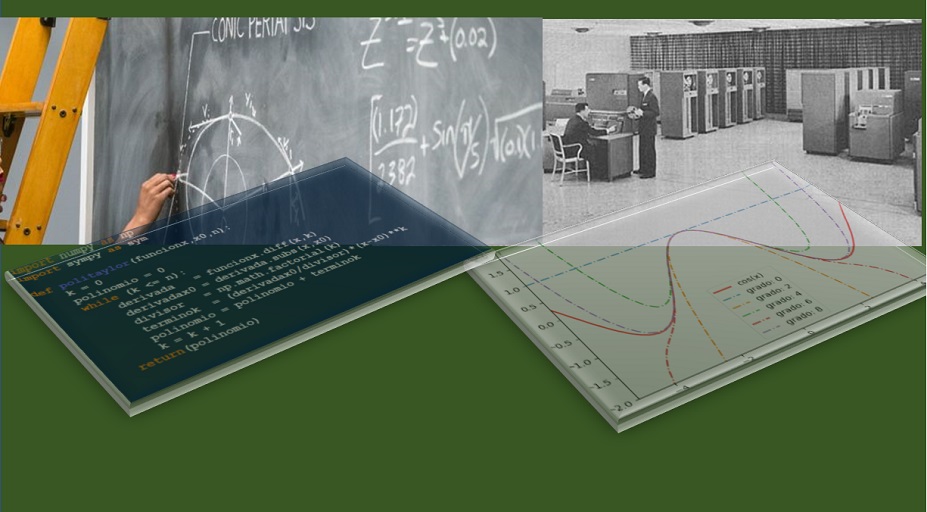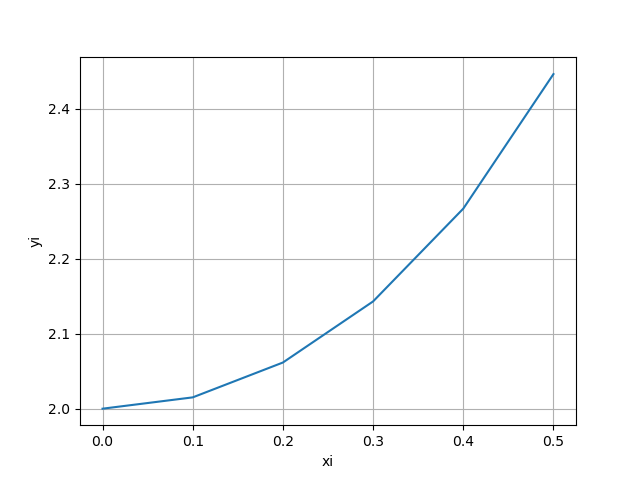Ejercicio: 3Eva_IIT2009_T2 Valor inicial Runge-Kutta 4to orden dy/dx
La ecuación del problema:
(1-x^2)y' - xy = x (1-x^2)se despeja:
(1-x^2)y' = x (1-x^2) - xy y' = x - \frac{xy}{(1-x^2)}con valores iniciales x0 = 0 , y0 = 2, h = 0.1 en el intervalo [0, 0.5]
Usando Runge-Kutta de 2do Orden
Iteración 1
K_1 = h y'(0,2) = (0.1)\Big[0 - \frac{0 (2)}{(1-(0^2))}\Big] = 0 K_2 = h y'(0+0.1, 2 + 0) = (0.1)\Big[0.1 - \frac{0.1 (2+0)}{(1-(0.1^2))}\Big] = 0.0302 y_1= 2 + \frac{0+0.0302}{2} = 2.0151 x_1 = x_0 + h = 0 + 0.1 = 0.1Iteración 2
K_1 = h y'(0.1,2.0151) = (0.1)\Big[0.1 - \frac{0.1 (2.0151)}{(1-(0.1^2))}\Big] = 0.0304 K_2 = h y'(0.1+0.1, 2.0151 + 0.0304) = (0.1)\Big[0.2 - \frac{0.2 (2.0151 + 0.0304)}{(1-(0.2^2))}\Big] = 0.0626 y_2 = 2.0151 + \frac{0.0304+0.0626}{2} = 2.0616 x_2 = x_1 + h = 0.1 + 0.1 = 0.2Iteración 3
K_1 = h y'(0.2,2.0616) = (0.1)\Big[0.2 - \frac{0.2 (2.0616)}{(1-(0.2^2))}\Big] = 0.0629 K_2 = h y'(0.2+0.1, 2.0616 + 0.0629) = (0.1)\Big[0.3 - \frac{0.3 (2.0616 + 0.0629)}{(1-(0.3^2))}\Big] = 0.1 y_3 = 2.0151 + \frac{0.0629+0.1}{2} = 2.1431 x_3 = x_2 + h = 0.2 + 0.1 = 0.3siguiendo el algoritmo se completa la tabla:
[xi, yi, K1, K2 ] [[0. 2. 0. 0. ] [0.1 2.0151 0. 0.0302] [0.2 2.0616 0.0304 0.0626] [0.3 2.1431 0.0629 0.1 ] [0.4 2.2668 0.1007 0.1468] [0.5 2.4463 0.1479 0.211 ]]
Algoritmo en Python
# 3Eva_IIT2009_T2 Valor inicial Runge-Kutta 4to orden dy/dx import numpy as np import matplotlib.pyplot as plt # INGRESO d1y = lambda x,y : x + x*y/(1-x**2) x0 = 0 y0 = 2 h = 0.1 a = 0 b = 1/2 # PROCEDIMIENTO muestras = int((b -a)/h)+1 tabla = np.zeros(shape=(muestras,4),dtype=float) i = 0 xi = x0 yi = y0 tabla[i,:] = [xi,yi,0,0] i = i+1 while not(i>=muestras): K1 = h* d1y(xi,yi) K2 = h* d1y(xi+h,yi+K1) yi = yi + (K1+K2)/2 xi = xi +h tabla[i,:] = [xi,yi,K1,K2] i = i+1 # vector para gráfica xg = tabla[:,0] yg = tabla[:,1] # SALIDA # muestra 4 decimales np.set_printoptions(precision=4) print(' [xi, yi, K1, K2]') print(tabla) # Gráfica plt.plot(xg,yg) plt.xlabel('xi') plt.ylabel('yi') plt.grid() plt.show()
Tarea: Realizar con Runge-Kutta de 4to Orden

